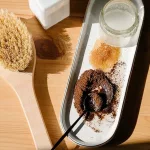Garlic has long been employed to address a wide range of ailments over the centuries, including earaches and ear infections. While rigorous scientific proof for garlic specifically treating ear infections is limited, garlic is known to offer a number of other health advantages.

Are any benefits of garlic supported by science?
Garlic demonstrates antiviral, antibacterial, and antifungal actions. It also possesses anti-inflammatory and analgesic qualities. Consuming garlic can bolster your immune response and aid in fighting infections.
Applied topically, garlic may help alleviate earache discomfort.
An older trial involving 103 children with middle ear infection pain reported that naturopathic ear drops containing garlic (Allium sativum) and other botanical components were as effective at managing ear pain as over-the-counter ear drops.
A second older trial of naturopathic ear drops with 171 children experiencing ear pain suggested those herbal drops used alone might be more effective than anesthetic (numbing) ear drops for treating pediatric ear pain.
More recently, an in vitro study from 2019 discovered that allicin and S-allyl cysteine (SAC), two garlic-derived compounds, were capable of killing certain microbes that can cause ear infections.
However, these garlic-derived agents were less potent than the antibiotic ciprofloxacin and the antifungal drug fluconazole in that research.
Additionally, a 2020 review highlighted garlic’s notable antiviral activity, showing it can protect potential host cells from viral invasion, though viral causes of ear infections are less frequent than bacterial ones.
Overall, evidence for garlic-based ear treatments remains limited, and more robust studies are necessary to draw firmer conclusions.
How garlic is used for earache
Eating garlic can generally strengthen immunity, helping to prevent or combat infections. Garlic has been used traditionally for ear complaints including earache, ear infection, and even tinnitus. Below are a few home methods for using garlic related to ear issues.
Garlic oil
Pre-made garlic oil ear drops are available at many health shops, supermarkets, and online retailers.
If you prefer, you can prepare small amounts of garlic oil at home to use immediately.
Before you startConsider using home sterilization methods for utensils or storage jars if you intend to keep leftover oil. USDA guidance for sterilizing jars suggests covering the jar with water in a canner pot and boiling for at least 10 minutes (longer at elevations above 1,000 feet).
What you’ll need:
- 1 garlic clove, peeled
- 2 to 4 tablespoons olive oil
- small saucepan
- small glass jar with lid or dropper
- piece of cotton
- strainer
How to make garlic oil ear drops:
- Peel the garlic clove.
- Crush or roughly chop the garlic to release its juices.
- Place the garlic and oil in a small pan that hasn’t been heated yet.
- Warm the oil and garlic over low heat—you want it warm, not hot. The oil is too hot if it smokes or bubbles.
- Swirl the oil until it becomes aromatic.
- Remove from heat and allow the mixture to cool.
- Pour the garlic-infused oil into the jar, straining out the garlic bits.
How to apply the garlic oil drops:
Have the person with the ear problem lie on their side with the affected ear facing upward.
Gently place two or three drops of warm garlic oil into the ear. Lightly cover the ear opening with the cotton to prevent the oil from leaking out. The person should remain in that position for 10 to 15 minutes.
Alternatively, soak the cotton in the oil and rest it just inside the ear so the oil can seep into the ear canal.
Store any remaining oil in the refrigerator in the glass jar for future use.
Storing garlic oilThe International Association for Food Protection (IAFP) and the FDA strongly advise refrigerating garlic-infused oil and using it within three days after preparation.
Whole garlic clove
A whole peeled garlic clove can be placed by the ear to address ear pain or tinnitus. This approach is not recommended for children.
What you’ll need:
- one peeled garlic clove
- small piece of gauze
- warm washcloth
How to do it:
Peel a garlic clove and slice off the tip of one end. Wrap the clove in gauze and rest the wrapped clove at the ear opening with the cut end pointed into the ear. The clove should not be inserted into the ear canal. Hold a warm washcloth over the ear until the discomfort diminishes.
If pain increases, stop using the garlic and consult a healthcare professional.
Risks of garlic oil
There is a possibility of skin irritation or chemical burns from applying garlic or garlic-based substances to the skin. Test any homemade remedy on a small patch of skin (for example, the inner forearm) before using it on yourself or someone else.
If you or the person being treated feel tingling, burning, or notice redness at the application site, wash the area thoroughly with soap and water and discontinue use.
Do not use if the eardrum is ruptured
These remedies should not be applied if the eardrum is perforated. A ruptured eardrum can cause pain and sometimes fluid drainage from the ear. Consult your physician before using garlic oil or other ear remedies if you suspect a ruptured eardrum.
Risk of bacterial growth
Bacteria like Clostridium botulinum can grow under specific conditions in garlic oil, particularly when containers or ingredients aren’t properly sterilized. C. botulinum can produce botulinum toxin in contaminated food and cause botulism.
Kinds of ear infections
Otitis media
Otitis media refers to a middle ear infection caused by bacteria or a virus leading to inflammation behind the eardrum. This infection is very common among children. Middle ear infections often resolve without drugs, but see a healthcare provider if ear pain persists or is accompanied by fever.
Otitis externa
Otitis externa affects the outer ear and ear canal. Swimmer’s ear is the most common form of otitis externa and is linked to moisture exposure, such as frequent swimming. Water trapped in the ear canal can promote bacterial growth.
Other options for ear pain relief
Garlic is not the only choice for managing an ear infection.
Middle ear infections frequently clear up on their own, and symptoms can be eased with over-the-counter pain medications. Warm or cold compresses may also provide comfort, along with other home remedies for earaches.
If ear pain continues or is accompanied by fever or facial pain, consult your healthcare provider.
Bottom line
Although robust scientific evidence for garlic treating ear infections is limited, garlic and similar home remedies may help reduce pain.
Talk with a nurse or doctor if you have questions or concerns about earache or using garlic-based topical treatments.


















Leave a Reply
You must be logged in to post a comment.